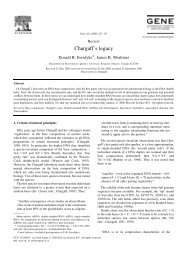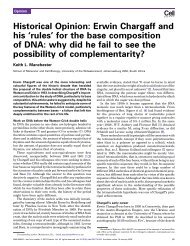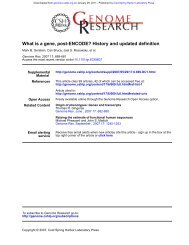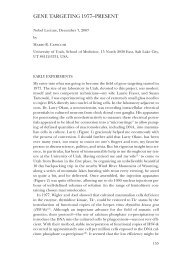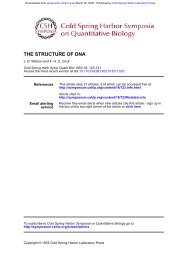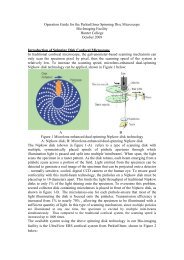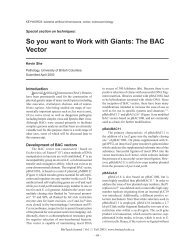Chemical specificity of nucleic acids and mechanism of ... - Biology
Chemical specificity of nucleic acids and mechanism of ... - Biology
Chemical specificity of nucleic acids and mechanism of ... - Biology
You also want an ePaper? Increase the reach of your titles
YUMPU automatically turns print PDFs into web optimized ePapers that Google loves.
204 E. CHARGAFF; <strong>Chemical</strong> Specificity <strong>of</strong> Nucleic Acids <strong>and</strong> Mechanism <strong>of</strong> their Enzymatic Degradation [EXPERIi~NTIA VOL. VII6]<br />
convenient. The separation <strong>of</strong> the pyrimidines is carried<br />
out in aqueous butanol (colmnn 1).<br />
Following the separation, the location <strong>of</strong> the various<br />
adsorption zones on the paper must be demonstrated.<br />
Our first attempts to bring this about in ultraviolet<br />
light were unsuccessful, probably because <strong>of</strong> inadequate<br />
filtration <strong>of</strong> the light emitted by the lamp then<br />
at our disposal. For this reason, the expedient was<br />
. . . .<br />
RF 4 5 6 7 8 9 10 It 12 I5<br />
.,oJ . . . . . . . . l|o<br />
'3°-( t° "ll" 1',' i-<br />
.9 0<br />
1.00<br />
), V°V ° I!:<br />
n o,n a n a n a n n NH 3 o o<br />
B B B Co Co O B [3<br />
M M Q D D HCI<br />
O<br />
HCI<br />
Schematic representation <strong>of</strong> the position on the paper ehromatogram<br />
<strong>of</strong> the purines <strong>and</strong> pyrimidi~nes following the separation <strong>of</strong> a mixture.<br />
.4 adenine, G guanine, H hypoxanthiue, X xanthine, U uracil,<br />
C cytosine, T thymine. The conditions under which the separations<br />
were performed are indicated at the bottom, a acidic, ff neutral,<br />
/3 n-butanol, M morpholine, D diethylene glycol, Co eollidine,<br />
Q quinoline.<br />
(Taken from E.VIsCHER <strong>and</strong> E.CHAIIGAFF, J. Biol. Chem. 176,<br />
704 [1948].1<br />
used <strong>of</strong> fixing the separated purines or pyrimidines on<br />
the paper as mercury complexes which then were made<br />
visible by their conversion to mercuric sulfide. The<br />
papers thus developed served as guide strips for the<br />
removal <strong>of</strong> the corresponding zones from untreated<br />
chromatograms that were then extracted <strong>and</strong> analyzed<br />
in the ultraviolet spectrophotometer. The development<br />
<strong>of</strong> the separated bases as mercury derivatives has,<br />
however, now become unnecessary, except for the<br />
preservation <strong>of</strong> permanent records, since there has for<br />
some time been available commercially an ultraviolet<br />
lamp emitting short wave ultraviolet ("Mineralight",<br />
Ultraviolet Products Corp., Los Angeles, California).<br />
With the help <strong>of</strong> this lamp it is now easy to demonstrate<br />
directly the position <strong>of</strong> the separated purines<br />
<strong>and</strong> pyrimidines (<strong>and</strong> also <strong>of</strong> nucleosides <strong>and</strong> nucleo-<br />
tides 1) which appear as dark absorption shadows on<br />
the background <strong>of</strong> the fluorescing filter paper <strong>and</strong> can<br />
be cut apart accordingly. (We are greatly indebted to<br />
Dr. C. E. CARTER, Oak Ridge National Laboratory,<br />
who drew our attention to this instrumentS.)<br />
The extracts <strong>of</strong> the separated compounds are then<br />
studied in the ultraviolet spectrophotometer. The<br />
measurement <strong>of</strong> complete absorption spectra permits<br />
the determination <strong>of</strong> the purity <strong>of</strong> the solutions <strong>and</strong><br />
at the same time the quantitative estimation <strong>of</strong> their<br />
contents. The details <strong>of</strong> the procedures employed have<br />
been published a. In this manner, adenine, guanine,<br />
uracil, cytosine, <strong>and</strong> thymine (<strong>and</strong> also hypoxantlfine,<br />
xanthine, <strong>and</strong> 5-methylcytosine 4) can be determined<br />
quantitatively in amounts <strong>of</strong> 240 y. The precision <strong>of</strong><br />
the method is ±4% for the purines <strong>and</strong> even better<br />
for the pyrimidines, if the averages <strong>of</strong> a large series <strong>of</strong><br />
determinations are considered. In individual estimations<br />
the accuracy is about +6%.<br />
Procedures very similar in principle served in our<br />
laboratory for the separation <strong>and</strong> estimation <strong>of</strong> the<br />
ribohucleosides uridine <strong>and</strong> cytidine <strong>and</strong> for the<br />
separation <strong>of</strong> desoxyribothymidine from thymine.<br />
Methods for the separation <strong>and</strong> quantitative determination<br />
<strong>of</strong> the ribonucleotides in an aqueous ammonium<br />
isobutyrate-isobutyric acid system have likewise been<br />
developed ~.<br />
VI. Methods o/ Hydrolysis<br />
It has long been known that the purines can be split<br />
<strong>of</strong>f completely by a relatively mild acid hydrolysis <strong>of</strong><br />
the <strong>nucleic</strong> <strong>acids</strong>. This could be confirmed in our<br />
laboratory in a more rigorous manner by the demonstration<br />
that heating at 100 ° for 1 hour in N sulfuric<br />
acid effects the quantitative liberation <strong>of</strong> adenine <strong>and</strong><br />
guanine from adenylic <strong>and</strong> guanylic <strong>acids</strong> respectively 6.<br />
The liberation <strong>of</strong> the pyrimidines, however, requires<br />
much more energetic methods <strong>of</strong> cleavage. Heating<br />
at high temperatures with strong mineral acid under<br />
pressure is usually resorted to. To what extent these<br />
procedures brought about the destruction <strong>of</strong> the<br />
pyrimidines, could not be ascertained previously<br />
owing to the lack <strong>of</strong> suitable analytical procedures.<br />
The experiments summarized in TaMe I, which are<br />
quoted from a recent paper 6, show that the extremely<br />
robust.cleavage methods with mineral <strong>acids</strong> usually<br />
employed must have led to a very considerable degradation<br />
<strong>of</strong> cytosine to uracil. Uracil <strong>and</strong> also thymine<br />
are much more resistant. For this reason, we turned to<br />
1 E.CgARGArV, B.MAGASANIK, R.DoNIC.ER, <strong>and</strong> E.VIscttER, J.<br />
Amer. Chem. Soc. 71, 1513 (I949).<br />
~- A similar arrangement was recently described by E. R.HoLIDAY<br />
<strong>and</strong> E.A.JoHNSON, Nature 163, 2.I6 (t949).<br />
a E.VlSeHER <strong>and</strong> E.CItARGAFF, J. Biol. Chem. 17a, 703 (1948).<br />
4 j. KREAM <strong>and</strong> E.CHARGAFV, unpublished experiments.<br />
s E.VIscHER, B.MAGxSAmK, <strong>and</strong> E.CI~ARaAF~, Federation Proc.<br />
s, ~6a (1949). - E.CHARGAFF, B.MAoASANIK, R.DoNIaER, <strong>and</strong><br />
E.VlSCHER, J. Amer. Chem. Soe. 71, 1513 (1949).<br />
s E.VlsCHER <strong>and</strong> E.CttAROAFF, J. Biol. Chem. 176, 715 (1948).



